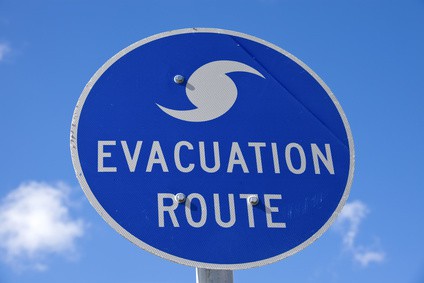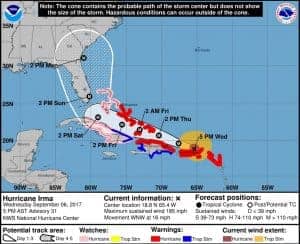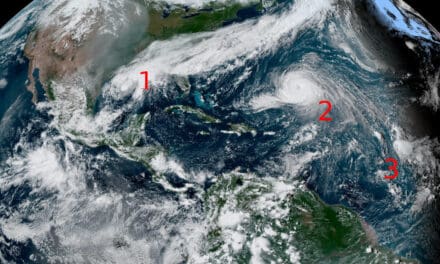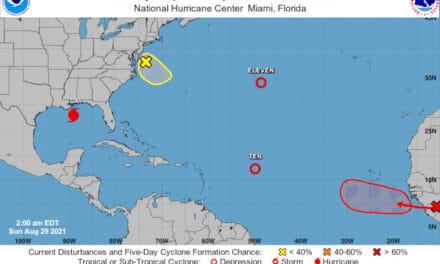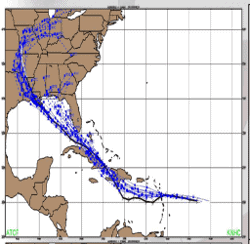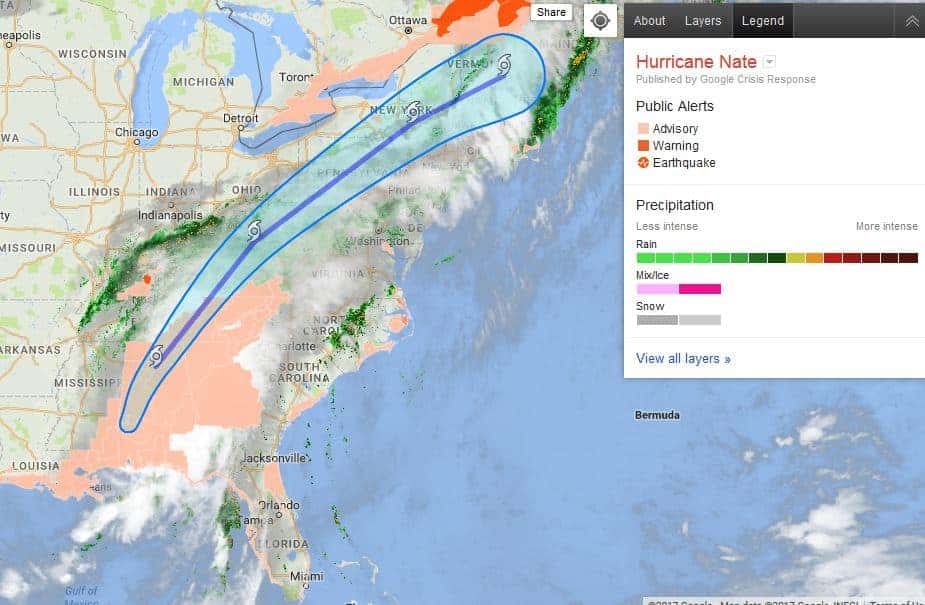Texas struggles to recover from Harvey as Irma Barrels in with 185 MPH Sustained Winds
Update: 6-Sept-2017 6:00 EDT
Irma, an extremely powerful hurricane with 185 MPH winds and a diameter of over 500 miles, has hit the Lessor Antilles with wind gusts over 200 MPH and will affect Puerto Rico tonight, Hispaniola Tomorrow, and Cuba on Friday.
Sometime after reaching Cuba, the storm will turn north toward Florida. The size of the storm means it will impact virtually the entire Peninsula and then probably out over water again before reaching Georgia, South Carolina, and North Carolina, though the exact timing and tracks are not yet known.
Florida has mandatory evacuations and Georgia has declared a state of emergency. Check with local authorities. If you are ordered to evacuate, leave as soon as possible.
—
As Texas residents continue to deal with the power outages and flooding in the aftermath of Harvey, a new threat for Gulf and East Coast residents is just days away.
Hurricane Irma, a strong category five major hurricane is likely to retain most of its strength over the next five days. Hurricane warnings and watches are issues for northeastern Lessor Antilles Islands and are spreading to the Greater Antilles Islands as Irma heads for the Gulf of Mexico.
Watches and Warnings are issued from St. Johns to Puerto Rico, Dominican Republic, and Haiti.
Irma’s exact track beyond five days remains uncertain, but it will affect the Florida Peninsula and Keys later this week and into the weekend. In the uncertain area just beyond the current forecast track, Irma will turn to the north, either just before or as it reaches the Florida Peninsula, or possible just after. The exact track is still unknown.
Unsure how to prepare? Start Here Hurricane Preparedness
Fuel Efficient Inverter Generators for Emergencies
National Hurricane Center Key Messages.
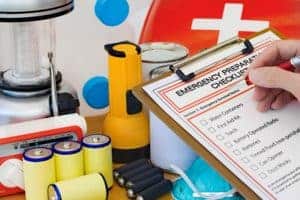
Florida, East and Gulf Coasts Make Preparations as Hurricane Irma Approaches
Irma will bring life-threatening wind, rains, storm surge and rainfall hazard to the northeastern Leeward Islands beginning later today and the Virgin Islands and Puerto Rico tomorrow. Residents should rush to complete storm preparations before the arrival of tropical storm force winds later today.
The Bahamas, Dominican Republic, southeast Bahamas and the Turks and Caicos are under hurricane watches. Irma will bring dangerous wind, storm surge, and rainfall on Friday to these islands on Friday.
Irma could directly threaten the Bahamas and Cuba as a major hurricane later this week. Residents should monitor the storm and prepare as they listen to the advice given by local officials.
The Florida Peninsula and Florida Keys face storm impacts later this week are increasing. Residents in these areas should prepare for a major hurricane.
Portable Emergency Generators up to 17,500 Watts Ready to Ship
Irma a potentially catastrophic storm
Everyone in hurricane-prone areas should ensure that they have their hurricane plan in place.
- Stay up to date on the storm and listen to local officials. Those living in possible evacuation zones should review their evacuation route and be ready to grab their evacuation kit and leave. Don’t forget to make preparations for pets and take them with you when you evacuate.
Warning: If you are told to evacuate, close up your home and follow the evacuation route. Do not stay and try to ride out this dangerous storm.
Evacuation Supply Kit – Go Bag- Make the kit easily portable so you can grab it and leave within minutes.
- Flashlights with extra batteries, first aid kit, cash, medications, and copies of your critical information.
- Make a communication plan and choose a single point of contact who will disseminate information to your family and friends.
- Keep cell phones and mobile devices charged. One the storm hits, use the batteries sparingly. You may not have a chance to recharge for days.
- Review plans with family so that everyone is prepared to follow the plan.
- Make Emergency Preparations for Food, Shelter, and Electricity.
- Stock non-perishable food and water for a week and include foods for those with special dietary needs. Plan a minimum of one gallon of water per day, per person. Include pet foods and water for the pets.
- Refill prescriptions now to prevent running out and avoid the long lines at the last minute.
- Check on relatives and friends that may have difficulty evacuating or preparing for the storm. Help them make a plan and assist them in preparing.
- Buy gasoline for portable generators. Stock generator maintenance supplies for at least two weeks of use. New spark plugs, oil and air filters, and oil are the minimum. Most portables will need maintenance at least once per week.
- Determine which room you will stay in during the storm. Choose a small interior room without windows if possible. Move your disaster kit and supplies to the room.
FEMA Recommends a Portable Generator for Disaster Preparation
If you don’t already have one, FEMA recommends you purchase a portable generator to supply power after the storm goes out. They can keep refrigerators and freezers operating, supply a window air conditioner, operate a sump pump, and keep a few lights on or power small kitchen appliances such as coffee makers and crock pots or electric flying pans.
- Never operate a generator inside your home or in any enclosed space.
- Protect the generator from rain, but don’t impede the air flow around the generator. One possible location is under a picnic table located 20 feet from the home.
- Never try to power your home by plugging it into an appliance outlet. Backfeeding is dangerous and most small generators can’t power your entire home.
- Use extension cords rated for the power you draw. Each 15- or 20-amp generator outlet requires its own 12-gauge grounded extension cord rated for outdoor use.
Important Terms to Know and Understand
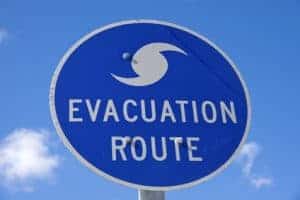
Follow Evacuation Route Signs. Listen to Local Officials
Hurricane Warning – Hurricane conditions are expected in less than 36 hours. Make final preparations and if ordered to evacuate, take your evacuation go bag and leave by your designated route.
Hurricane Watch – Hurricane conditions will likely reach the areas under the watch within 48 hours. Rush your preparations and listen to local officials for possible evacuation orders.
Storm Surge – A mound of water that rushes inland over land and through waterways. Storm surge is the most dangerous hazard of a hurricane. Storm surges up to forty feet or more are not uncommon.
Flash Flood – When land uphill of a small river or stream, gully, ditch, or roadway, or anywhere water can flow freely, is inundated with torrential rain, the accumulated water can rush down the waterway while carrying debris. Flash floods can submerge vehicles in seconds and rise rapidly. Never try to cross moving water with a vehicle. Sudden floods can cause other hazards such as washed out roads, sink holes caused by the flood, or unstable bridge supports.
Inland Flooding – After storm surge, this is the most dangerous hazard. Heavy rains can inundate and saturate an area causing flood waters to rise and making escape impossible by blocking roads and other routes. Flooding prevents evacuation once the storm begins.
Hurricane-Force Winds – Sustained winds above 74 MPH and up to 180 MPH. Every hurricane is different. A strong, wide hurricane will have hurricane force winds over a much wider area than a smaller, less intense hurricane.
Tropical-Storm-Force Winds – Sustained winds from 39 to 73 MPH. In a hurricane, these winds extend beyond the outermost hurricane-force winds.
Rip Current – A strong current that sweeps everything within it out to sea and away from shore. Avoid beaches as the hurricane approaches. If caught in a rip current, do not try to fight the current by swimming toward shore. Swim parallel to the current until out of its grasp, then make your way toward shore. No swimmer is strong enough to fight a rip current. Rip currents can occur days before the hurricane reaches land.
Portable Emergency Generator – A generator that is not fixed in place or permanently connected to a building. Models range from less than 2000 watts up to 17,500 watts.
Standby Generator – Backup Generator – A permanently installed automatic generator that supplies power during an outage. Most operate off natural gas or propane and don’t require stockpiling fuel or frequent refueling. The moment the power goes out, they start and run automatically without human intervention

